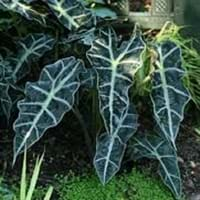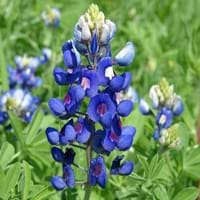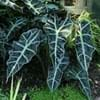Life Span
Annual
Perennial
Type
Tender Perennial
Flowering Plants
Origin
Hybrid origin
Mediterranean, North Africa, Northern America
Types
Alocasia macrorhizzos, Alocasia odora
Anthony Peak Lupine, Silver Bush, Garden Lupine, Spider Lupine, Adonis Lupine
Number of Varieties
Not Available
Habitat
Pastures, Wet forest
Pine barrens, Sandy areas
USDA Hardiness Zone
10-12
3-7
Sunset Zone
H1, H2, 22, 23, 24
1a, 1b, 2a, 2b, 3a, 3b, 4, 5, 6, 7, 14, 15, 16, 17
Habit
Clump-Forming
Upright/Erect
Flower Color
White
Blue, Pink, White
Flower Color Modifier
Not Available
Not Available
Fruit Color
Red
Not Available
Leaf Color in Spring
Lime Green, Dark Green, Bronze
Light Green
Leaf Color in Summer
Lime Green, Dark Green, Bronze
Green
Leaf Color in Fall
Green, Lime Green, Dark Green, Bronze
Green
Leaf Color in Winter
Lime Green, Dark Green, Bronze
Not Available
Leaf Shape
V-Shaped
Oblovate
Plant Season
Spring, Summer, Fall, Winter
Summer
Sunlight
Partial shade, Full Shade
Full Sun, Part sun
Type of Soil
Loam
Loose, Moist
The pH of Soil
Acidic, Neutral
Slightly Acidic
Soil Drainage
Well drained
Well drained
Bloom Time
Indeterminate
Late Spring, Summer
Tolerances
Drought
Not Available
Where to Plant?
Container, Ground
Ground
How to Plant?
creeping rhizomes, Vegetative Reproduction
Seedlings
Plant Maintenance
Medium
Medium
Watering Requirements
Needs a lot of water initially
Form a Soil ring to water efficiently, Keep the ground moist but not water-logged, Requires a lot of watering, Water in morning to avoid prompting diseases
In Summer
Lots of watering
Lots of watering
In Spring
Moderate
Moderate
In Winter
Average Water
Average Water
Soil pH
Acidic, Neutral
Slightly Acidic
Soil Type
Loam
Loose, Moist
Soil Drainage Capacity
Well drained
Well drained
Sun Exposure
Partial shade, Full Shade
Full Sun, Part sun
Pruning
No pruning needed, Remove damaged leaves, Remove dead branches, Remove dead leaves
Prune ocassionally
Fertilizers
since leafy plants, use higher nitrogen content fertilizer, slow-release fertilizers
All-Purpose Liquid Fertilizer
Pests and Diseases
Alternaria Leaf Spot, Leaf rust, Leaf spot, Snails
Aphids, Fusarium wilt, Root rot, Thripes
Plant Tolerance
Full Sun, Humidity, Soil Compaction
Drought
Flowers
Insignificant
Yes
Flower Petal Number
Single
Single
Foliage Texture
Bold
Medium
Foliage Sheen
Glossy
Matte
Attracts
Butterflies, pollinators, Snakes
Bees
Allergy
conjunctivitis, Itchy eyes, Sore Throat, Vomiting
Abdominal pain, Asthma, Nausea, Swelling in the face, Vomiting
Aesthetic Uses
Beautification, Cottage Garden, Showy Purposes
Showy Purposes
Beauty Benefits
Glowing Skin, Hair Conditioner
Not Available
Edible Uses
Sometimes
Yes
Environmental Uses
Absorbs huge amounts of CO2, soil stabilisation, Very little waste
Air purification
Medicinal Uses
Aging, Digestion problems, Rheumatism
Anthelmintic, Diuretic, Treatment of ulcers
Part of Plant Used
Leaves, Rhizomes
Flowers, Seeds
Other Uses
Application in Handicrafts, Florist trade and landscaping, Showy Purposes
Showy Purposes, Used as Ornamental plant, Used for fragrance
Used As Indoor Plant
No
No
Used As Outdoor Plant
Yes
Yes
Garden Design
Container, Feature Plant, Houseplant, Mixed Border, Tropical
Bedding Plant, Container, Feature Plant, Foundation, Rock Garden
Botanical Name
ALOCASIA x amazonica
Lupinus
Common Name
African Mask, Amazon Taro, Elephant Ear
Hybrid Lupine
In Hindi
Alocasia
वृक संयंत्र
In German
Alocasia
lupine
In French
Alocasia
usine de lupin
In Spanish
Alocasia
planta de lupino
In Greek
Alocasia
φυτό λούπινο
In Portuguese
Alocasia
tremoço planta
In Polish
Alocasia
łubin roślin
In Latin
Alocasia
Plinio herba
Phylum
Tracheophyta
Magnoliophyta
Class
Liliopsida
Magnoliopsida
Clade
Angiosperms, Monocots
Not Available
Tribe
Colocasiodeae
Not Available
Subfamily
Aroideae
Faboideae
Number of Species
Not Available
Importance of Kris Plant and Lupine
Want to have the most appropriate plant for your garden? You might want to know the importance of Kris Plant and Lupine. Basically, these two plants vary in many aspects. Compare Kris Plant and Lupine as they differ in many characteristics such as their life, care, benefits, facts, etc. Every gardener must at least have the slightest clue about the plants he wants to plant in his garden. Compare their benefits, which differ in many ways like facts and uses. The medicinal use of Kris Plant is Aging, Digestion problems and Rheumatism whereas of Lupine is Anthelmintic, Diuretic and Treatment of ulcers. Kris Plant has beauty benefits as follows: Glowing Skin and Hair Conditioner while Lupine has beauty benefits as follows: Glowing Skin and Hair Conditioner.
Compare Facts of Kris Plant vs Lupine
How to choose the best garden plant for your garden depending upon its facts? Here garden plant comparison will help you to solve this query. Compare the facts of Kris Plant vs Lupine and know which one to choose. As garden plants have benefits and other uses, allergy is also a major drawback of plants for some people. Allergic reactions of Kris Plant are conjunctivitis, Itchy eyes, Sore Throat and Vomiting whereas of Lupine have Abdominal pain, Asthma, Nausea, Swelling in the face and Vomiting respectively. Having a fruit bearing plant in your garden can be a plus point of your garden. Kris Plant has no showy fruits and Lupine has no showy fruits. Also Kris Plant is not flowering and Lupine is flowering. You can compare Kris Plant and Lupine facts and facts of other plants too.





